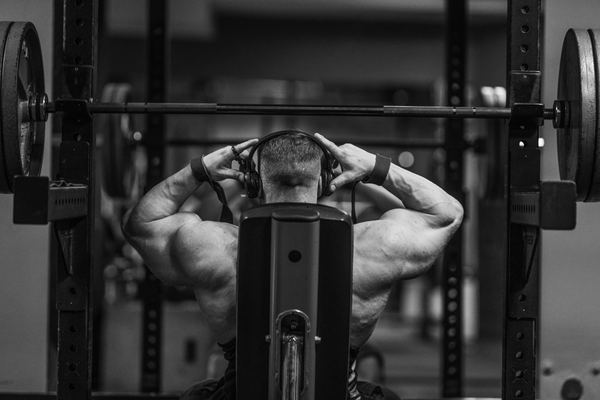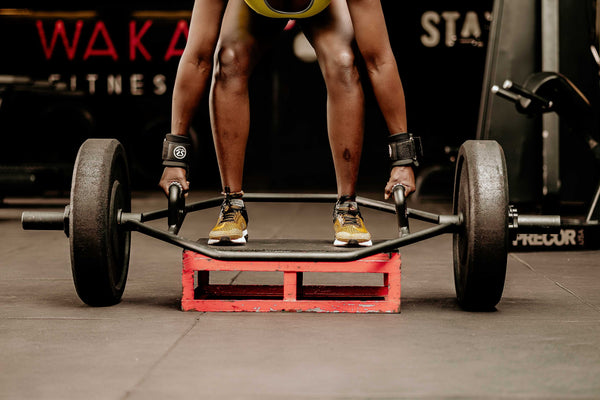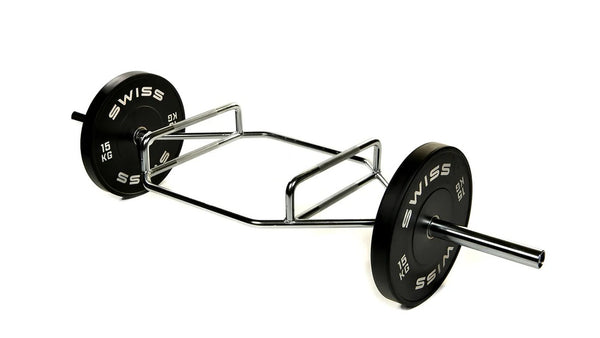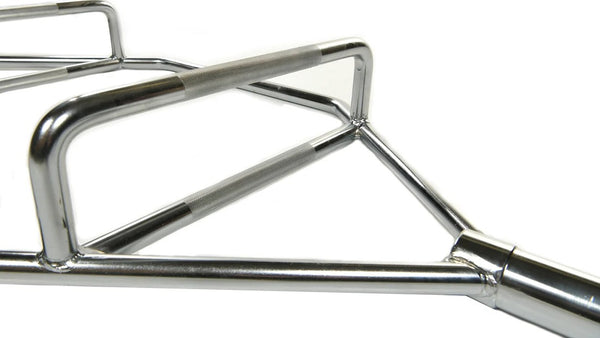In the ever-evolving landscape of fitness, enthusiasts are constantly seeking new and effective ways to enhance their training routines. One piece of equipment that has gained popularity in recent years is the hex bar, also known as the trap bar. This unique, hexagonal-shaped bar offers a versatile and engaging alternative to the traditional barbell, opening up new possibilities for your workouts. In this blog, we will explore the purpose of a hex bar, its main benefits, and delve into ten exciting ways to integrate hex bar exercises into your fitness regime.
Understanding the Hex Bar
What is the Purpose of a Hex Bar?
The hex bar, or trap bar, was designed with functionality and biomechanics in mind. Its primary purpose is to provide a more natural lifting position, accommodating a more upright posture during exercises. This design places less stress on the lower back, making it an ideal tool for individuals with lower back issues or those looking for a safer and more comfortable lifting experience.
Benefits of Using a Hex Bar:
- Reduced Lower Back Stress: As mentioned, the hex bar promotes a more upright posture, reducing the strain on the lower back.
- Increased Quadriceps Activation: Hex bar exercises often engage the quadriceps more effectively than traditional barbell lifts, making it an excellent choice for targeting this muscle group.
- Versatility: The hex bar's unique design opens the door to a wide range of exercises, providing a comprehensive full-body workout.
- Beginner-Friendly: The hex bar is often considered more accessible for beginners, offering a smoother learning curve for those new to weightlifting.
People who might decide to work out using a hex bar/trap bar include:

Weightlifters: Hex bars are commonly used by weightlifters for exercises like deadlifts. The design of the hex bar allows for a more upright posture during the lift, which can be beneficial for individuals with back issues or those looking to target specific muscle groups.
Athletes: Hex bars are popular among athletes for strength and power training. They can be used to perform a variety of compound exercises, helping to improve overall athletic performance.
Individuals with Back Issues: The hex bar allows for a more neutral spine position during exercises like deadlifts, which can be beneficial for individuals with lower back issues. It can be a suitable alternative for those who find a traditional straight bar deadlift uncomfortable.
Beginners: Some beginners find the hex bar deadlift to be more accessible than the traditional barbell deadlift. The neutral grip and the ability to stand inside the bar may make it easier for beginners to learn proper form.
General Fitness Enthusiasts: People who are focused on general fitness and strength training may choose to incorporate the hex bar into their workouts as a versatile tool for various exercises.
Rehabilitation: The hex bar can be used in rehabilitation settings for individuals recovering from injuries. The design of the bar allows for controlled and safer movements, making it a suitable option for rehabilitation exercises.
Individuals Targeting Specific Muscle Groups: Some individuals may prefer the hex bar for exercises like shrugs or farmer's walks, as the design allows for a more natural hand position and movement.
Ultimately, the decision to use a hex bar depends on personal preferences, fitness goals, and any specific considerations such as existing injuries or physical limitations.
Hex Bar vs. Standard Barbell

What's the Difference Between a Hex Bar and a Standard Barbell?
The hex bar's hexagonal shape distinguishes it from the traditional straight barbell. This shape allows the lifter to stand within the bar, with the handles at their sides. In contrast, a standard barbell has a straight design, requiring the lifter to stand behind it.
- Grip Variation: The hex bar offers multiple grip positions, allowing for both neutral and pronated grips. This versatility contributes to a more personalised and comfortable lifting experience.
- Biomechanical Advantages: The hex bar's design encourages a more natural lifting pattern, aligning the body's centre of mass with the load, resulting in reduced stress on the lumbar spine.
- Specific Exercise Applications: While a standard barbell is excellent for certain exercises like bench press and traditional squats, the hex bar shines in movements that benefit from a more upright position, such as deadlifts and hex squats.
Exploring Hex Bar Exercises

Now that we've established the purpose and benefits of the hex bar, let's dive into ten dynamic exercises that can elevate your workout routine:
Isolate and strengthen the trapezius muscles with hex bar shrugs. The neutral grip and ergonomic design of the hex bar provide a comfortable and effective way to target the upper traps.
Execution: Stand in the centre of the hex bar, grip the handles, and proceed to engage your traps by shrugging your taps towards your ears. Maintain good posture and do not round your shoulders.
Benefits: This exercise adds load to the upper traps which will reduce the risk of injury in your shoulders and improve your ability to push overhead and as well as perform Olympic lifts.
10. Hex Bar High Pulls:
Benefit: Targets the traps, shoulders, and upper back, enhancing overall pulling strength.
Execution: Start in a deadlift position, explosively pull the hex bar towards your chest, keeping your elbows high.
Looking at the Hex Bar Deadlift in more details:

The hex bar deadlift is a compound exercise that targets multiple muscle groups, making it an effective full-body movement. The primary muscle groups worked during a hex bar deadlift include:
Hamstrings: The hamstrings, located at the back of the thigh, play a significant role in extending the hip joint during the upward phase of the hex bar deadlift.
Glutes: The gluteal muscles (gluteus maximus, medius, and minimus) are heavily involved in hip extension, contributing to the lifting phase of the hex bar deadlift.
Quadriceps: The quadriceps muscles, located at the front of the thigh, are engaged as the lifter straightens the knee joint to lift the hex bar.
Erector Spinae (Lower Back): The erector spinae muscles, running along the spine, are activated to stabilise the spine during the lifting phase, helping to maintain an upright posture.
Trapezius and Rhomboids: The upper back muscles, including the trapezius and rhomboids, are used to stabilise and retract the shoulder blades during the lift.
Forearms and Grip Muscles: The hex bar deadlift requires a strong grip to hold onto the handles of the hex bar. This engagement works the muscles in the forearms and hands.
Core Muscles: The core muscles, including the abdominals and obliques, play a crucial role in stabilising the spine and preventing excessive movement during the hex bar deadlift.
Latissimus Dorsi (Lats): The lats, which are large muscles in the back, are engaged to stabilise the shoulder girdle and contribute to the overall stability of the movement.
Calf Muscles: The calf muscles (gastrocnemius and soleus) are involved in plantar flexion of the ankle during the lifting phase.
The hex bar deadlift is a versatile exercise that engages both the lower and upper body, making it an excellent choice for overall strength development. Additionally, the neutral grip and body positioning in the hex bar deadlift may make it more comfortable for some individuals compared to the traditional straight bar deadlift.
Improving your deadlift can contribute to enhanced athletic performance for several reasons:
Full-Body Strength: The deadlift is a compound exercise that targets multiple muscle groups simultaneously, including the lower back, glutes, hamstrings, quadriceps, upper back, and grip muscles. Developing strength in these areas contributes to overall full-body strength, which is beneficial for various athletic activities.
Explosive Power: The deadlift involves lifting a heavy load from a static position, requiring explosive power during the initial phase of the lift. This power development is essential for activities like jumping, sprinting, and other explosive movements common in many sports.
Improved Posture and Core Stability: Deadlifts require maintaining a neutral spine and engaging the core muscles. Strengthening the core and improving posture can enhance stability and balance, which are crucial for athletic performance and injury prevention.
Functional Movement Pattern: The deadlift mimics a fundamental movement pattern—lifting a load from the ground. This movement is functional and applicable to various real-life and athletic situations, making it a valuable exercise for building practical strength.
Increased Grip Strength: The deadlift places significant demands on grip strength. Improved grip strength can be advantageous in sports that involve holding onto equipment, grappling, or any activity where a strong grip is essential.
Injury Prevention: Strengthening the muscles involved in the deadlift, particularly the posterior chain (backside of the body), can contribute to injury prevention. A strong and resilient musculoskeletal system is less prone to injuries during athletic activities.
Enhanced Overall Performance: As a full-body exercise, the deadlift has the potential to positively impact various aspects of physical fitness, including strength, power, muscular endurance, and cardiovascular fitness. These improvements can translate to better overall athletic performance.
Sport-Specific Benefits: Depending on the sport, the deadlift may have specific carryover benefits. For example, in sports like football or rugby, the ability to generate force from the ground (as in a deadlift) can be crucial for tackling, pushing opponents, or accelerating quickly.
Mental Toughness: Deadlifts, especially when lifting near-maximal weights, require mental focus, discipline, and perseverance. Developing mental toughness through challenging lifts can positively impact an athlete's ability to handle pressure and adversity in competition.
It's important to note that while the deadlift is a valuable exercise, a well-rounded training program should incorporate a variety of exercises to address specific needs and goals. Additionally, proper form and technique are crucial to prevent injuries, so it's recommended to seek guidance from a qualified fitness professional when incorporating deadlifts into a training regimen.
Unveiling the Open Hex Bar
What's an Open Hex Bar?
The open hex bar is a variation that features an opening in the centre, allowing for easier entry and exit during exercises. This design is particularly beneficial for individuals with mobility restrictions or those who prefer a more seamless transition in and out of the bar.
How to maintain your Hex Bar:

Clean the Bar: Before storing the hex bar, make sure it is clean and free from any dirt, chalk, or moisture. Wipe it down with a dry cloth or a slightly damp cloth if necessary.
Store in a Dry Area: Hex bars are typically made of metal and can be prone to rust if exposed to moisture. Store the hex bar in a dry area, away from damp or humid conditions. If the bar becomes wet during use, dry it thoroughly before storage.
Keep it Indoors: While some exercise equipment can withstand outdoor conditions, it's generally best to store a hex bar indoors to protect it from the elements. If you must store it outside, use a weatherproof cover to shield it from rain and other weather conditions.
Conclusion
In conclusion, the hex bar is a valuable addition to any fitness arsenal, offering a multitude of benefits and exercise variations. From hex squats to farmer's walks, each movement provides a unique challenge, making your workouts more engaging and effective. Whether you're a seasoned lifter or just starting your fitness journey, incorporating hex bar exercises can contribute to a well-rounded and injury-resistant physique. So, step into the hexagonal world of strength and elevate your workouts with this versatile piece of equipment.
